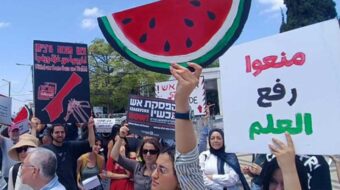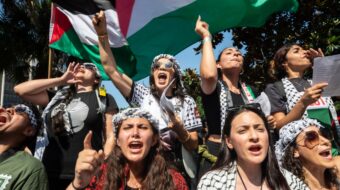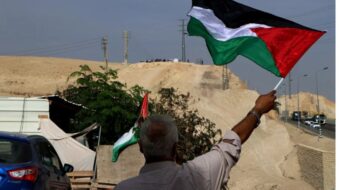
KENT, Ohio—Students at Kent State University gathered to demand that the university administration disclose its investments in the State of Israel and immediately divest any and all financial support as a result of the ongoing genocide in Gaza.
Hundreds of students, faculty, and community members gathered at the site of the May 4, 1970 massacre of 4 Kent State students, killed by the Ohio National Guard while protesting the expansion of the Vietnam war into neighboring Cambodia. Students for Justice in Palestine (SJP), Jewish Voice for Peace (JVP), and other groups played a role in organizing the student-led protests against the ongoing war on Gaza.
The demonstration occurs in the aftermath of weeks of the growing upsurge on college campuses nationwide, as peaceful student-led demonstrations against the complicity of the U.S. government and leading American institutions in the ongoing genocide in Gaza have been met by stunning police brutality and disregard for constitutional rights to free speech and assembly.
Police violence against overwhelmingly peaceful protesters raged through the week from Columbia University and University of Virginia in the east, to the University of Texas Austin, Cal Poly Humboldt, and UCLA in the west, and here in Ohio with 41 students and community members being arrested and their encampment violently dispersed on Thursday, April 25 at Ohio State University.
President Joe Biden affirmed on Thursday that the protests have not changed his position on U.S. support for Israel. Administration officials went further, smearing the demonstrations with implications of excessive damage and discrimination.
“Forcibly taking over buildings is not peaceful—it is wrong. And hate speech and hate symbols have no place in America,” Biden declared. The near complete destruction of Gaza, including the destruction of every single one of its universities, and the deaths of over 35,000, including as many as 14,000 children, have as yet failed to stir such strong emotions from the Biden administration at any time in the 7 months since the war began.
In contrast to the moral ambiguity of their elected officials, students at Kent State put the conflict in stark terms. “Israel bombs, USA pays. How many kids have you killed today?!” rang one chant from the crowd, echoing near identical chants used to criticize LBJ during the 1960s.
“We have been building up to this all year, holding teach-ins on Palestine and organizing the student body”, said Yizun Issawi, an organizer with SJP, “And we won’t stop. The genocide in Gaza doesn’t stop because our school year ends and neither will we. We’re going to keep pushing the administration to disclose and divest until the genocide stops.”
Cindy Barber, a member of the community supporting the student’s anti-genocide demonstration, commented on the similarities between the present moment and the student led opposition to the Vietnam war.
Many students strongly opposed the presence of ROTC on campus in the 1960s. The ROTC building was burned down during the protests ,although it was never made clear how that had happened. “Back then, my friends and I were thinking about how to get the university out of the war…. We were also looking at the Liquid Crystal Institute, where the university was taking all this money from the government to develop technologies for the war in Vietnam.”
Developed war technology
In the 1960s, Kent State researchers had developed the technology that now underlies ubiquitous LCD displays, something that was of high interest to weapons manufacturers. “The push for disclosure and divestment today is important. How do you get the money out of the war machine?”
Barber also commented on the role of the media, “These images of the atrocities in Vietnam were on the front page of the paper and on the TV in the days before May 4. And now the images of the genocide in Gaza and police brutality across the college campuses are everywhere and creating this sense of immediacy.”
Police presence at the demonstration was limited to perhaps a dozen officers, who stood well apart from the crowd and were not as heavily armed as those seen at other universities in the past week, including the nearby Ohio State University which had hosted riot squads and rooftop snipers a few days earlier. This may have been because students at Kent State did not attempt to establish an encampment, a tactic employed at many other universities across the country and even internationally in recent weeks.
However, the biggest reason for the relatively light police presence was obvious. “Because of what happened on May 4, they knew all eyes would be on them. That couldn’t happen again”, said Issawi, referring to Kent State administrators.

Kent State University president Todd Diacon spoke at an officially sanctioned memorial that overlapped with the student-led rally, emphasizing a vision of free speech in which all sides are treated with equal deference, “I honor the presence of our protesters just as I honor those who disagree.”
As Diacon spoke a small group of about five counter-demonstrators lingered on the outskirts of the massive student gathering opposing the genocide in Gaza. The will of the students could not have been more starkly laid out before his eyes, yet Diacon felt obliged to equivocate, “We must not demonize our opponents.”
This “all sides matter” deference from Diacon was familiar to Kent State students, whose vigorous opposition to the university’s hosting of Kyle Rittenhouse as a guest speaker just two weeks prior was ignored by administrators. Rittenhouse was acquitted of murdering two men and wounding another after traveling across state lines with an assault rifle to oppose Black Lives Matter protests in Kenosha, Wisconsin in 2020.
In the 54 years since the murders of Allison Krause, Jeffery Miller, William Schroeder, and Sandra Scheuer by Ohio National Guardsmen, Kent State students have gathered each year on May 4 to remember and reflect. Over the years, it was the students who insisted on keeping the legacy of the victims alive, persisting in the May 4 remembrance events without official sanction and in spite of multiple attempts by the university to obfuscate the history of May 4, including the construction of a parking lot on the site where the 4 students were killed. It was not until 1999 that the first official memorial markers were installed at the site.
This struggle—the struggle to remember, to retain the painful memories and lessons of May 4, 1970 against those who would find such truths inconvenient—has been the backbone of a strong and unbroken tradition of radicalism and liberation among the subsequent generations of Kent State University students. The university has maintained one of the country’s largest Peace and Conflict Studies programs since 1973. And in 2001, Kent State became the first university in Ohio to found an LGBTQ studies program.
The Victory Bell hangs from a brick mount in the grassy lawn of Kent State’s front campus. The bell was acquired by the Alpha Phi Omega fraternity from the Erie Railroad in 1952 and was sounded to celebrate athletic victories during the university’s seemingly idyllic 1950s heyday. By 1970, students would sound the bell to signal the start of political rallies and protest, as they did the morning of May 4, 1970, when national guardsmen fired first tear gas and then at least 67 live rounds into the students gathered around the bell.
Survivors of May 4, 1970, once again sounded the Victory bell on Saturday, which rang loud and clear over a new generation of student activists on the same grassy hill where four students were murdered by the state 54 years ago and where generations of Kent State students have gathered to oppose the war in Vietnam, violent interventions in Central America and Eastern Europe, and the wars in Iraq and Afghanistan. It rang out once again in support of the struggle for freedom and solidarity that extends across all international and intergenerational boundaries.
As the ringing died out, an organizer told the crowd, “This movement is never going to die until Palestine is free! You all have a role to play.”
We hope you appreciated this article. At People’s World, we believe news and information should be free and accessible to all, but we need your help. Our journalism is free of corporate influence and paywalls because we are totally reader-supported. Only you, our readers and supporters, make this possible. If you enjoy reading People’s World and the stories we bring you, please support our work by donating or becoming a monthly sustainer today. Thank you!












Comments